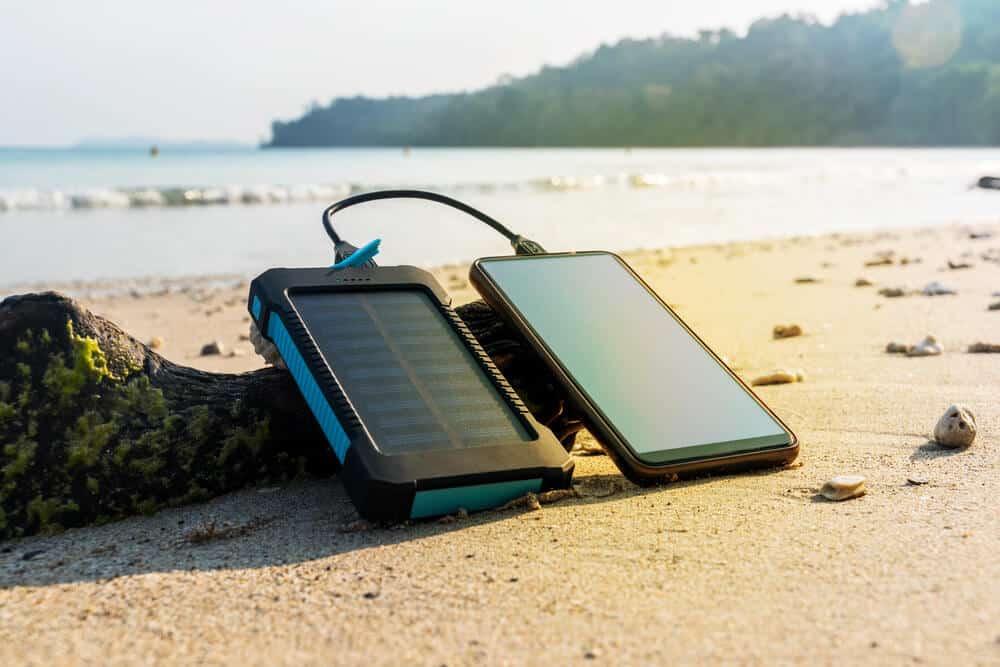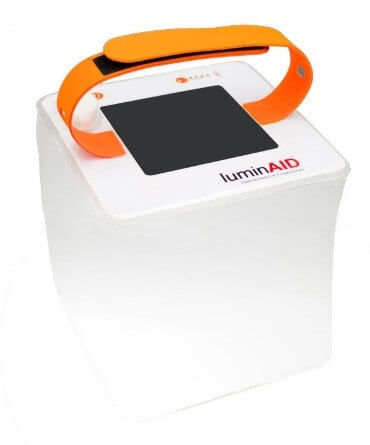Sometimes you just want to get off the grid and go into the bush, but safety is a priority. So before you rely on your phone battery, grab yourself one of the best portable solar charger kits, money can buy here in Australia.
Gone are the days of a dead battery hampering an overnight trip, or the lack of electricity. With these ingenious devices, you can use the sun's rays to charge any device.
The bigger the pack, the more juice, but for travellers, backpackers, overnight trips, you can definitely make do with some of the smaller models.
1. Luminaid Packlite Hero Supercharger
Designed for adventurers who go outside the grid, the Luminaid Packlite Hero 2-in-1 Supercharger is a handy lantern and solar phone charger in a small unit for easy packing.
The all-in-one piece of gear is inflatable. When deflated it’s only an inch flat (2.5cm) and weighs only 10 oz (284gms).
Fully charged by its solar panel the charger function holds sufficient power to charge your phone 2 to 3 times, as well as powering a handy camping light.
The lantern has 5 brightness and an SOS emergency flash mode. The brightness levels range from Low (10 lumens) to Turbo (300 lumens). Four LED battery indicators keep you alerted to its charge level.
A Lycra strap and carabiner loops give you several options around packing this versatile piece of camping equipment.
Packing it against the back of your pack facing whatever sun you receive during your hiking or other adventure makes charging a breeze.
It’s waterproof as well – you can submerge it in a body of water and it’ll be right as rain!
This is great for camping, caving, night walks, even backyard BBQ’s if you don’t have other lighting. Its charge will keep the light going for many hours.
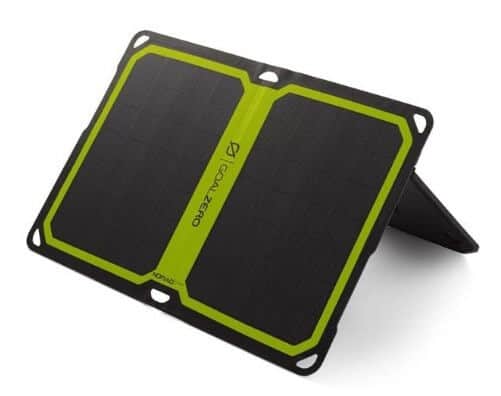
2. Goal Zero Nomad 7 Plus Charger
Lighter and smarter than the rest, the solar-powered Nomad 7 Plus Solar Panel charger can charge any USB device without the need for an electricity source.
All you need to do is charge it up from the sun.
This is an excellent companion for people who want a standby charger when on the go or off the grid. It’s light, small and extremely portable.
The detachable kickstand gives it modularity and the power flow indicator ensures that you always know when you need to recharge it.
The folded measurements of this little unit are 16.5*22.2*1.9cm and it weighs only 363gm with its kickstand (260gms without).
It features a 5V USB port and a mini solar port (2.5mm) and has an auto-restart function and intelligent electronics which optimises its output to suit the device being charged and reconnects automatically when charging is stopped before the device has reached 100% charge.
An easy to read LED indicator tells you the optimal solar positioning to make the most of the sunshine when you’re charging it.
Using the kickstand when charging devices means that you can optimise the shade and angle placement. It’s weatherproof and has a vented pocket for temperature regulation.
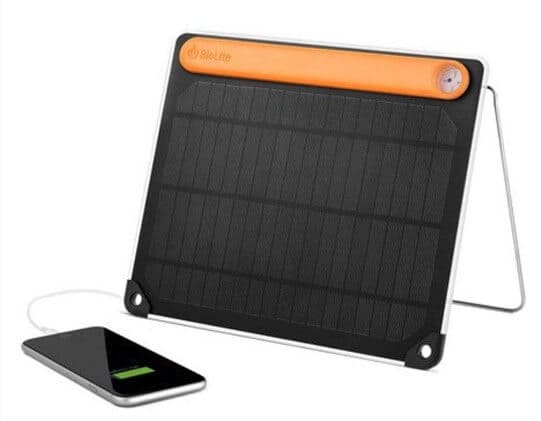
3. Biolite Solarpanel 5+ Plus
Power phones and other USB devices whenever and wherever you are with the Biolite SolarPanel 5+.
This is a portable and lightweight little device that uses the sun to recharge itself so that it can recharge other devices.
The unit features an Optimal Sun System which uses an integrated sundial to maximise the capture of the sun’s rays. It tells you where to angle it, using the 360-degree kickstand, even on uneven surfaces.
Its battery is a powerful 2200mAh Lithium-ion cell which can store enough energy to charge any USB 5W device.
The solar panel is a high-efficiency monocrystalline cell panel.
It also features battery and charge strength indicators for measuring the sun’s strength and therefore the panel’s capacity. A battery status button lets you see the energy your battery has left.
You also have the option of charging it from an electrical source at home with the Micro-USB port.
The unit measures 25.7*20.8*2.4cm and weighs only 390gms so it’s very portable and can be attached to a backpack.
Attach it on the outside and make use of the sun you may be in as you’re on the go or n a hike.
This is a fantastic little unit for hikers, campers and others who go off the grid.
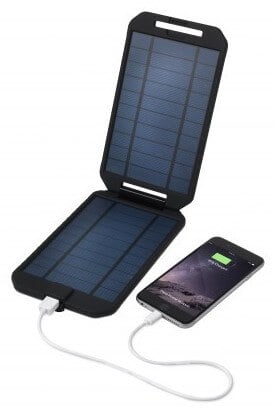
4. Powertraveller Extreme Solar Kit
Ideal for charging your smaller electronic devices like phones, GPS, cameras, MP3, etc the PowerTraveller Extreme Solar Kit is lightweight and very portable.
The Extreme is the top of the range solar power charger from PowerTraveller, a brand which is well known for these products.
This is a clamshell solar panel which features a USB 5W 5V or 12V charging port. The flip-open panel has a 210-degree angle so its perfect for getting the optimum sunshine and for attaching to backpacks, tents, panniers etc.
MPPT technology in the panel allows for power to be delivered from the charger even in low light conditions.
It does need to be noted that this charger does not have the ability to store power so you do need to have some sunlight or other light source to use it as a charging device.
A two-colour LED indicator alerts to Red when solar charging is at its minimum and Green when it’s at its optimum level.
It measures a compact 20.1*11.4*1.6mm and weighs only 289gms and features a handy Velcro strap, so portability is not an issue.
The kit includes a USB to Micro-USB connection cable.
The housing is water-resistant and tough, so it’s ideal for wilderness adventurers, campers, hikers, and general day-to-day use on the outside of a pack or other carrier.
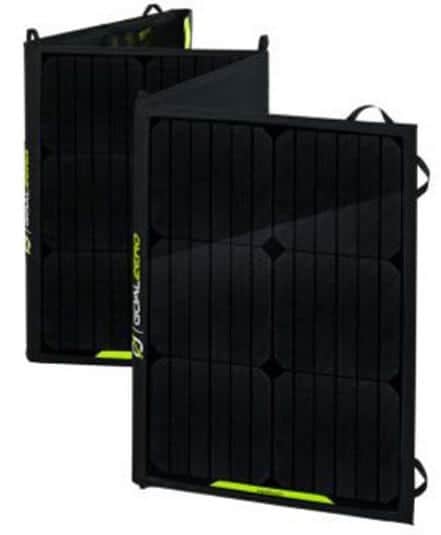
5. Goal Zero Nomad 100 Solar Panel
The largest solar panel available from Goal Zero, the Nomad 100 Solar Panel is intended for adventurers in the rugged outdoors off-grid.
It is a standard MC4 connector for 3rd-party charge controllers and integrated charging cable for Sherpa Power Packs and Goal Zero Yeti Solar Generators.
It’s designed to be chained to each other as well for increasing the power input and therefore the output.
The panel does not store energy so you need sunlight when you use it.
It will not work indoors – it does need sunlight, not unnatural light. However, you can store its power in an independent power pack (refer above).
The unit can deliver up to 100W of power but that does depend on the brightness of the sunlight it’s receiving.
For example, the Nomad will charge a Yeti 150 for 3-6 hours, a Yeti 400 for 8-16 hours and a Yeti 1250 for 24-48 hours. It will also charge the Sherpa 50 and 100 models.
These are the products which work best with the Nomad 100 but it will charge other devices. The panel measures (unfolded) 52*151.1*2.54cm and weighs 4.6kg. Folded it measures 52*39.3*5.1cm.
This is a comparatively large solar panel. It’s powerful, rugged and designed for basecamps, mobile 4X4’ campervans and so on with the chaining ability. But it is foldable so is fine for campers, trekkers, hikers etc as well.
How to choose best portable solar charger?
Here's the top things to look for when buying your device.
Weight
Of course the most important aspect is the weight of the device.
Depending on where you'll be taking the device, or how far you'll be carrying it, will help you decide whether you opt for a heavy or lightweight option.
The heavier the unit, generally the more solar panels, or the larger the panels, so you should consider what you'll be charging too.
Backpacking and charging a camera or smartphone won't require anything too powerful, but charging a Yeti mini fridge might require something much more powerful.
Size / Portability
This leads us nicely into the next point and that's that size does matter.
Likewise, larger devices often have more power but will be heavier. There are some small devices available which are good for carrying in a backpack, but you'll only be able to charge 1 or 2 devices at a time.
USB solar chargers are normally quite portable, whereas ones that offer an electrical socket to charge a device, might be much less portable.
What can you charge with a solar charger?
Depending on the model that you choose, you'll be able to charge the following:
- Cell phones
- iPhones
- Laptops
- iPads
- Tablets
- LED lights
- 12V batteries
- Mini Fridges
- Power Banks.
How many watts does a solar charger need?
Ultimately you'll need at least 5W to charge a modern smartphone. Newer models such as the iPhone X will require more, so take a look at your mobile charger and determine how much you're going to need, before purchase.
The best solar chargers to get are those that come with smart IC feature that helps to detect the current of the device and increase the amps automatically if required or faster charging.
If you're looking for a tablet or iPad you'll probably need a 15W solar charger.
A laptop will likely need 25W or more, maybe even 30-40W.
All of these will likely impact the size and weight, which can hamper your portability.
Related: Travel Packing Cubes

- 10+ Best Project Management Software - October 23, 2020
- 5+ Best Motorcycle Paddock Stands [Top Rated] - October 6, 2020
- 5+ Best PDF Editing Software That Actually Works - July 27, 2020
Last Updated: December 3, 2021 by Rhys
